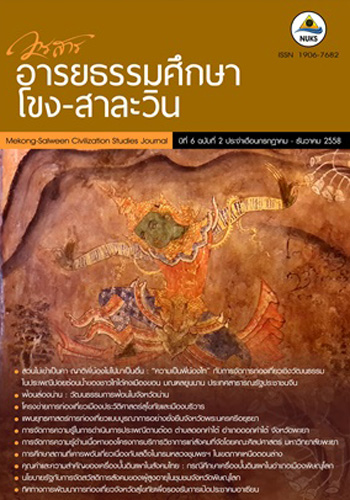ฟ้อนล่องน่าน : วัฒนธรรมการฟ้อนในจังหวัดน่าน
Main Article Content
Abstract
ผลการวิจัยพบว่าฟ้อนล่องน่านมีพัฒนาการมาจากการฟ้อนบนลำเรือ ซึ่งปรากฏหลักฐานในพงศาวดารเมืองน่าน ปีพ.ศ. 1902 กล่าวถึงพระยาการเมืองเจ้าผู้ครองนครย้ายเมือง จากวรนคร (ที่ราบแถบอำเภอศิลาเพชร อำเภอปัว จังหวัดน่าน) ลงมาตั้งถิ่นฐานอยู่ที่ภูเพียง แช่แหง้ (ที่ราบทางตอนล่างทางฝั่งตะวันออกของพระธาตุแช่แหง้ ) ขณะล่องแพขนย้ายสิ่งของ และผู้คนลงมาตามลำน้ำน่าน ผู้โดยสารบางคนเกิดความเมื่อยล้าจึงลุกขึ้นฟ้อนตามเสียงดนตรี จากนั้นรูปแบบการฟ้อนบนลำเรือได้รับการพัฒนาตามลำดับ โดยเริ่มปรากฏหลักฐานอย่าง ชัดเจนในขณะที่เมืองน่านมีฐานะเป็นหัวเมืองประเทศราช ปกครองโดยเจ้าผู้ครองนครภายใต้ กำกับกรุงรัตนโกสินทร์ ตราบจนยกเลิกระบบเจ้าผู้ครองนครเรื่อยมาจนปัจจุบัน ผู้วิจัยสามารถ แบ่งพัฒนาการการฟ้อนได้ 4 ระยะ ตามลำดับเหตุการณ์ดังนี้ 1) ฟ้อนบนเรือแข่งโดยชาวบ้าน สามัญชนและราชสำนัก 2) ฟ้อนน่านในคุ้มหลวง 3) ฟ้อนน่านแพร่กระจายออกนอกคุ้มหลวง 4) ฟ้อนล่องน่านที่จัดระเบียบมาตรฐานโดยสำนักงานวัฒนธรรมจังหวัดน่าน โดยมี องค์ประกอบในการแสดง ได้แก่ ผู้แสดงประกอบด้วย กลุ่มชาวบ้าน กลุ่มนักเรียนนักศึกษา และกลุ่มบริษัทจัดการแสดง กระบวนท่าฟ้อนแต่เดิมใช้ท่าฟ้อนที่นำมาจากฟ้อนลายงาม ซึ่งหากฟ้อนบนเรือสามารถเคลื่อนไหวเท้าได้เพียงเล็กน้อย แต่หากฟ้อนบนบกจะดีดส้นเท้า ขึ้นสูงก่อนการยํ่าเท้าทุกครั้ง ต่อมาได้มีการนำท่ารำมาตรฐานทางด้านนาฏศิลป์ไทยภาคกลาง มาประยุกต์ในการฟ้อน วงดนตรีที่ใช้ประกอบการฟ้อน คือ วงกลองล่องน่าน ซึ่งหากเป็นการ ฟ้อนบนลำเรือจะประกอบด้วยเครื่องดนตรี ได้แก่ กลองสองหน้า ฆ้อง แน และปาน แต่หาก ฟ้อนบนบกจะประกอบด้วยเครื่องดนตรี ได้แก่ กลองแอว ฆ้อง แน ฉาบ เพลงที่ใช้บรรเลง คือ เพลง “มอญเรือแข่ง” แต่งกายประกอบด้วยการนุ่งซิ่นม่าน สวมเสื้อแขนกระบอก ห่มสะไบ เกล้าผมมวยกึ่งกลางศีรษะ ติดดอกเอื้องผึ้ง และนิยมนำออกแสดงในงานมงคลเท่านั้น
ปัจจุบันฟ้อนล่องน่านได้เข้าไปมีบทบาทในชุมชนทั้ง 15 อำเภอ ของจังหวัดน่าน การฟ้อนในงานประเพณีสำคัญของชุมชนทำให้ประชาชนตระหนักถึงคุณค่าและความสำคัญของฟ้อนล่องน่าน เพราะสามารถสื่อให้เห็นถึงวัฒนธรรมอันเป็นเอกลักษณ์ของชาวเมืองน่าน ได้เป็นอย่างดี จากการประชุมระดมความคิดเห็นในการหาแนวทางอนุรักษ์ฟ้อนล่องน่านอย่าง ยั่งยืน พบว่าผู้เข้าร่วมประชุมส่วนใหญ่มีความต้องการให้หน่วยงานราชการ และเอกชน เข้ามามีส่วนร่วมในการสนับสนุน เผยแพร่ฟ้อนล่องน่าน และเห็นควรให้บรรจุฟ้อนล่องน่าน ไว้ในหลักสูตรการศึกษาท้องถิ่นทุกระดับชั้น นอกจากนี้ยังเสนอให้มีการประชาสัมพันธ์ ถึงแนวทางในการอนุรักษ์ฟ้อนล่องน่านให้แพร่หลายมากยิ่งขึ้น เพื่อประชาชนในพื้นที่จะได้มี ส่วนร่วมในการช่วยกันอนุรักษ์สืบสานวัฒนธรรมการฟ้อนของชาวจังหวัดน่านให้คงอยู่สืบไป
Fon Long Nan: Thai Northern Folk Dance in Nan Province
This study aimed to investigate the history of Fon Long Nan, the Thai northern folk dance on the oar in the Nan province, its pattern development, the factors contributing to its transformations, its patterns and characteristics, its status, and attitudes towards the dance values, as well as methods of preserving it persistently. The data was collected from printed documents, related research studies, in-depth interviews, reflections from photographs and video recordings, live stage performances, and participant observations with support from dance professionals, the data was collected from questionaires, and seminar of Fon Long Nan sustainable conservation.
The results showed that the history of the oar dance was first inscribed in 1902, when the town ruler Payakarnmuang, together with his people, migrated from Waranakorn to Wiang Phuphiang. In this migration there were processions of rafts and oars carrying belongings and musical instruments, as well as officials and town people,along the Nan River. While travelling, some people stood up and danced on the oars in order to relax. Later on, this dance was chronologically developed, the clear evidences of which were initially found in the period when Nan was a colonized town ruled by its royal ruler, under Rattanakosin’s supervision, followed by the period when the town ruler’s authority was cancelled and the current period. The researcher categorized the dance development in those periods into 4 patterns, as follows: 1) the dance on the racing oars performed by the locals and by the royal officials, 2) the dance in the royal palace, 3) the dance outside the royal palace, and 4) the dance standardized by the Cultural Office in the Nan Province, with the following characteristics. The dancers were the local volunteers, dance students, dance professionals hired by dance companies and restaurants. The dance pattern was originally Fon Lai Ngam, which allowed a small amount of foot movement if it was performed on an oar, but which permitted high foot rises if it was performed on land. Later, the Thai dance standardization was applied to the dance, and its foot rise was low according to the Thai dance standards.The Klong Long Nan music band played the Mon Rue Khaeng music. Dancewear included wearing a certain-style sarong and a long-sleeve blouse, with a hair bun in the center of the headdecorated with Dendrobium lindleyi Steud orchid flowers. The dance was commonly performed in auspicious ceremonies, yearly and exceptional.
Nowadays, Fon Long Nan has a crucial role in 15 districtcommunities of the Nan Province. The Fon Long Nan performance in foremost traditional festivals of the community helped the population to realize the value and significance of the dance because it well reflected the unique culture of the Nan people. According to a brainstorming meeting of Fon Long Nan dance’s resolute conservation methods, most participants showed their desires for the support and dispersion of the dance from both the government and private organizations and for the Fon Long Nan studies in the local educational curricula at all levels, as well as for the growing propagation of the dance conservation methods in order for the local people to help participate in preserving the provincial cultural dance.


